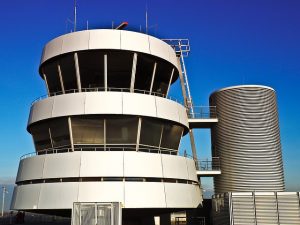 Air traffic controllers play an essential role in the commercial aviation industry. Also known as air traffic control specialists, they are responsible for safely guiding airplanes. They monitor the speed and trajectory of airplanes while relaying instructions to pilots. Even if you’re familiar with their general job description, though, there are probably some things about air traffic controllers that you don’t know. Below are five fun facts about air traffic controllers.
Air traffic controllers play an essential role in the commercial aviation industry. Also known as air traffic control specialists, they are responsible for safely guiding airplanes. They monitor the speed and trajectory of airplanes while relaying instructions to pilots. Even if you’re familiar with their general job description, though, there are probably some things about air traffic controllers that you don’t know. Below are five fun facts about air traffic controllers.
#1) Half-Hour Breaks Every 90 to 120 Minutes
To protect against fatigue, most air traffic controllers are required to take a half-hour break every 90 to 120 minutes. These breaks aren’t optional. They are mandatory. The reason being is that air traffic controllers may become fatigued when working for long periods. With mandatory breaks, air traffic controllers will stay energized and refreshed so that they are less experience fatigue.
#2) 14,000 Air Traffic Controllers
According to the U.S. Federal Aviation Administration (FAA), there are currently over 14,000 air traffic controllers employed in the United States. They typically work from a tall tower that overlooks an airport. There are hundreds of airports spread across the country, many of which contain an air traffic control tower. These air traffic control towers are fitted with radio transmitters and receivers that can exchange communications with airplanes.
#3) Maximum Training Age of 30
The FAA has a maximum age for enrolling in the air traffic controller training program. Aspiring air traffic controllers can’t enroll in the program unless they are 30 years of age or younger. Because of the technical nature of this job, it requires extensive training. The FAA realizes that people who are older than 30 are less likely to complete the training program. Therefore, it has a maximum training age of 30.
#4) Different Positions
While all air traffic controllers are responsible for safely guiding airplanes, there are several different positions for this job. Local air traffic controllers, for example, are those who work in an air traffic control tower. There are also ground air traffic controllers who, as you may have guessed, work on the ground. They issue taxing instructions so that airplanes can safely take off and land. Another job position is flight data. Flight data air traffic controllers receive and analyze squawk codes from airplanes.
#5) Use Their Own Language
Air traffic controllers use their own language when communicating with airplanes. Known as radiotelephony, it consists of lingo or jargon that’s broadly understood by pilots and other aviation professions. The term “wilco,” for instance, means that a message was received.



